|
Cardinal
Ratzinger nominated as the 266th Pope as Pope Benedict XVI
On Tuesday, April 19, 2005, the Vatican Conclave in a surprisingly
brief election process nominated John Paul II’s chief theological
advisor for over 20 years, Joseph Ratzinger from Germany, as the
265th “Apostolic Successor” to the seat of Peter in the Papacy. To
tens of thousands of pilgrims waiting in St. Peter’s square
cheering, Benedict XVI, with a large smile and wearing the
traditional regalia of the Papacy, waved to the faithful stalwarts.
He was elected on the second day, the fourth ballot, when over
two-thirds of the 115 cardinals (2 cardinals were absent due to
illness) made that fateful decision.
The “white smoke rising from
the Sistine Chapel chimney” sent the message that the conclave had
made its decision by 5:50 p.m. and ten minutes later, the bells
began to ring for the jubilant pilgrims. In a bid to the 1.1 billion
members of the Roman Catholic Church, Cardinal Jorge Arturo Medina
Estevez introduced the new Pontiff in traditional Latin. He began
his greeting to the “universal Church” by stating “brothers and
sisters” in several languages.
Who is this new Pontiff? As the head of the Congregation for the
Doctrine of the Faith, Cardinal Ratzinger was the director of
the
ancient Office of the Inquisition first started by the Dominicans
(founded by St. Dominic in 1217) in 1233 and later joined by the
Franciscan Order (founded by St. Francis of Assisi in 1209/10).
The
Inquisition ranks as probably the most heinous instrument of
evangelism and forced repentance ever instituted by a religious
institution. The Inquisitors terrorized the citizens of Europe for
centuries. It ended about 1850 CE but was later reinstituted by Pope
Paul VI (1963-1978) who restored the Inquisition under a more benign
name, the Congregation for the Doctrine of Faith. It was Pope John
Paul II who appointed Cardinal Joseph Ratzinger to this office.
There are interesting parallels as the fires of tribulation escalate
around the globe, the 111th and last pope, according to the
prophecies of St. Malachy, began his career in the Vatican directing
the ancient seat of the Catholic Inquisitors. With the visions of
the prophets in mind, all we have to see is the looming “False
Prophet” who will give his power to the anti-Christ and impel the
citizens of the
new One World Order to accept the “Mark of the
Beast” (Revelation 13:16-18)
As we begin this study into the deceptions that were surrounding the
death of Pope John Paul II and the election of Pope Benedict XVI,
let us begin to review the sacred numbers that will be used by the
Vatican hierarchy to guide their lives.
Go Back
Sacred
Numbers of the Luciferian Trinity
Spiritualist and occultists have their own language in which they
weave the messages sent by their master, Lucifer, the former
crowning angel that stood by the throne of the Almighty One. Here we
enter the world of those who seek the “illumination” of the gods of
the sphere,
the Illuminate; those who seek to identify with the
sacred geometry of Solomon’s Temple, the Masonic Order; and those
who seek to corrupt the sacred study of the mystical Hebrew faith in
the Kabbalah and form the Magick Qabalah and the Christian Cabalah.
Out of the corruption of the Torah based Kabbalah evolved the world
of magic in the Qabalah and the Islamic - Catholic- Christian
distortion of the Hebrew Kabbalah into the Christian Cabala. Out of
the loins of the sages of the Kabbalah came the fifty false messiahs
of Judaism, the last, the largest and the most fervent was the
messianic age of Shabbatai Zevi. He declared the “Age of the
Messiah” on June 18, 1666. (6th month, 6+6+6th day, 1000+666 year)
The legacy of this false messiah surrounds the Nation of Israel in
what are known as the Sabbatean Jews. To understand the
Book of
Revelation one has to know the Kabbalah for it is the Kabbalistic
numbers that the roots of the Satanic sacred numbers will be found.
You cannot understand Revelation’s “666” and the “Mark of the Beast”
without understanding the roots of Torah based Kabbalah and its
corruption into the Qabalah and Cabalah.
One of the most important things to know is that the followers of
Luciferian World Order are bound by sacred numbers and astrological
signs to guide their future path. The most important sacred satanic
numbers are the following:
-
“3” – This is the number of
the Pagan Trinity
-
“6” – This is the number of the
“Perfected Man”. Here we see the man made perfect by sacred
rituals practiced by occultic societies practiced by secret
societies that are within and in alliance with the Roman
Catholic Church. Any cluster of the same number that occurs
three times has the most powerful of occultic influence. As
such, the number of the anti-Messiah will be the number of
the “thrice Perfected Man”, and his number will be “666”
-
“11” – This is the number of the
coming anti-Christ. In the Book of Daniel, this anti-Messiah
is known as the “eleventh horn”. (Daniel 7:7-8) As we shall
soon see this present pope will be the “111th" pope of the
St. Malachy prophecy
-
“13” – This is the number of
extreme rebellion against constituted authority.
With these four numbers and the multiple
of each in mind, let us relook at the recent life of Karol Josef Woytyla as Pope
John Paul II and how these numbers surrounded his
life.
-
Karol Woytyla was 58 years old
at his coronation. Adding 5+8 = “13”
-
He was the 263rd “successor of
St. Peter” of the Roman Catholic Church. 263 à 2+6+3 = ”11”
-
He officially died on April 2,
2005 (4-2-2005). 4+2+2+0+0+5 = “13”
-
He lived exactly 31,000 days
from May 18, 1920 - April 2, 2005. In occultic calculations,
the number “13” is many times “hidden” by reversing the
numerology. So 31 is a hidden “13”. This is the number of
extreme rebellion “against the constituted authority of
Torah”
-
The number of full years the
Pope served as the Pontiff of the Roman Catholic Church was
26 years. 26 = “13”+”13”
-
The number of days the Pope
served as the Pontiff from October 16, 1978 to April 2, 2005
was 9665 days. 9+6+6+5 = “26” = “13” + “13”
This makes the following news item and
article even more interesting.
On April 1, 2005, it was reported on Fox News that Pope John Paul II
had died. The news media never did verify the story and Reuters
about a half hour later reported that the telemetry on the Pope was
still recording cardiac activity and the brain waves were still
being recorded. The actual time of death was not verified from the
Vatican until April 2, 2005 and the reported time of death was
21:38, Saturday, April 2, 2005.
"Rumours sweep Rome death was kept
hidden" - April 6, 2005
Rome (Sydney Morning Herald) - The politics of electing the next
pope moved into bizarre territory with rumours sweeping Rome of
a conservative plot to secure the papacy. In a conspiracy theory
worthy of a Dan Brown novel, liberals suggested that Pope John
Paul II had died a day earlier than was officially declared but
the news was withheld to give the conservatives an advantage.
According to the rumours, said to have come from sources in the
Italian Government and believed by senior cardinals, the Pope
died on Friday ... The rumour may sound far fetched but the fact
that it is circulating among - and is believed by - informed
liberal Vatican-watchers."
Here it is suggested that John Paul II
died on Friday, April 1 but it was not officially announced until
April 2, 2005 that he had died. For what advantage would it have
been to add another day? As we first noted in the sacred numbers
above, the number of the date of his death is “13”. Let us keep
learning the mindset of the Vatican hierarchy and the use of occultic symbols as they sent messages to those who read, observe
and follow occultic messages.
Go Back
Occultic Symbols
surrounding the Papacy
and the Funeral of
John Paul II
The Eight Wheel Path
of Enlightenment
The funeral of the John Paul II was centered on the majestic views
of the most famous basilica in the world, St. Peter’s Basilica in
the Vatican City at Rome.
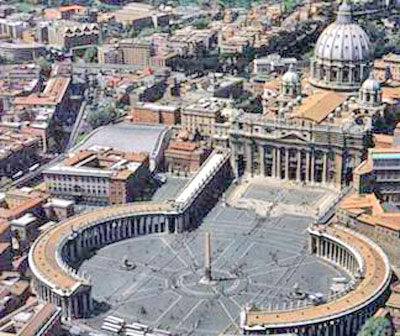
The St. Peter’s Basilica in Rome
As you look at this aerial picture of the rounded open plaza in
front of the cathedral, you can see that it is centered on an
Egyptian obelisk with the lines of the spokes of a wheel radiating
out to the eight cardinal directions of the globe. There also is an
opening in the plaza facing east and west. Here we are seeing the
“Eight Wheel Path of Enlightenment” centered on a circular hub.
The
root of this symbol is in Eight Paths of Enlightenment of Buddha
corrupted into what we call Black Magick today. The eight levels in
the path of learning are what a young neophyte in a satanic coven
must attain before he has reached the level of “full enlightenment”.
Yet the ancestral seat where this Eighth Wheeled of Enlightenment is
found is the “Throne of Satan”, the city of healing, Pergamos in
Asia Minor.
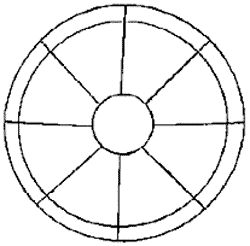
The Eighth Wheel – The Final Sexual Union with the divine
In Pergamos is where we enter into the world of the sacred goddess
and the god-kings. It is here where the eighth and final step of the
“Eight Wheel Path of Enlightenment” was the final “sex” with a
temple virgin as they participated with the divine as part of the
“Universal Life Regeneration Force.”
The city of Pergamos reminds us of the Apocalypse of John and the
seven churches. This is the region from where the black horse and
rider of the Apocalypse returns back to Jerusalem from the north as
the world awaits the beginning of the Black Seal of Revelation. This
is the city which hosts the most powerful religious institution in
the world today.
We can now see the Black Internationale as envisioned by Pope John
Paul II who, according to his mentor, Cardinal Wyszynski of Warsaw,
will win in the contest for global control of this planet earth. Is
it not amazing that the black horse and rider of the sixth seal
comes from the north of Jerusalem where the practitioners of “black
magic” lived in the ancient city of Pergamos where the “throne of
Satan” resided in the day when the Apocalypse of John was written.
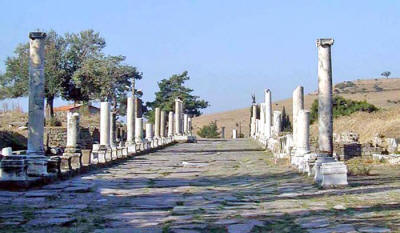
The temple of Aesculapius in the ancient city of Pergamos and home
to the physician Galen (131-210 CE)
Revelation 2:12-13 –
“And to the angel of the church in Pergamos
write, these things say He who has the sharp two-edged sword: I know
your works, and where you dwell, where Satan’s throne is. And you
hold fast to My name, and did not deny My faith even in the days in
which Antipas was My faithful martyr, who was killed among you,
where Satan dwells.”
Pergamos, was the capital city of Pergamum in
Mysia in the Caicus valley only 15 miles from the Aegean sea. Today
it is known as the city of Berghama. In this city was the famous
temple to Aesculapius, the Greek god of healing. He was recognized
as the founder of medical science. In this city also resided the
sacred priests and temple prostitutes of the black arts that fled
from Babylon the seat of Marduk the god of the Babylonians. The fame
of Pergamos was immortalized as the constellation of Ophiuchus.
The constellation of Ophiuchus, called the Thirteenth Constellation,
means “Serpent Holder”. This serpent is recognized as the serpent in
the Garden of Eden and the Serpent as Quetzalcoatl to the Aztecs
and the Serpent of Rukulcan to the Mayans. Is it any wonder that
every year, the path of the sun (the Sun god to the ancients)
travels through Ophiuchus between November 22 and December 25.
To the New Age devotees, this is the time of celebration of the
Christ consciousness or the galactic consciousness where the “wheel
of twelve”, the path of the disciples of Christ is transcended to a
Higher Self, the Thirteenth Self. This “New Age” is the Age of Ophiuchus where the wisdom of the ancients will be restored
especially the wisdom of “serpent energy”. Is it any wonder that the
last Age of Ophiuchus was from 4500 BCE to 2500 BCE when
the
“Watchers” as the “sons of God” came down and bred with the
“daughters of men” and begat
the giants of the ancients.
The citizens of the world came to Pergamos seeking health and
healing in the renowned medical capital of the Roman world. On the
hills of the Acropolis were splendid buildings and palaces with
statues and glorious works of art. Here in one of the great cities
of the ancient times, dedicated to the Babylonian
sun worship became the Roman seat of idolatry. The temples of
grandeur were dedicated to the god of Nature.
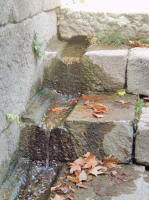 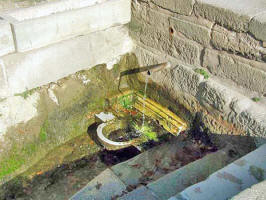
The heart of the site was its sacred spring. Visitors would drink
from its waters as the first step in their diagnosis. The outflow is
channeled to trickle down the side of stairs going down to the
underground corridor which connects it with the Temple of
Telesphorus
Here in the temples and shrine the pilgrims walked amongst thousands
of harmless snakes surrounding the altar of “Zeus the Savior”. The
medical arts of healing and the renowned institutions of medical
science were centered on the worship of the serpent. The temples in Pergamos were no less famous than the healing waters of
Lourdes
today. The art of medicine is memorialized today in the modern seal
of medicine; the caduceus, the staff of Aesculapius with a serpent
entwined around it.
After the forces of Cyrus the Great took possession of the city of
Babylon in 538 BCE the Babylonian priesthood were still allowed to
worship their arts and rituals in their ziggurat temples dedicated
to the Babylonian god, Marduk. Not willing to remain a religious
power force, the Chaldean priests attempted to usurp the throne of
the Persians when they installed one of their priests as king of
Babylon who posed as the king’s brother, Smerdis.
When the False Smerdis was discovered he was killed. Again the priests tried to set
up a Babylonian ruler and in 487 BCE, the Persian emperor Xerxes
destroyed Babylon, tore down the temple and toppled the golden
statue to Marduk. This was the golden statue of Nebuchadnezzar
that was famed by the fiery furnace story of the three Hebrew
Babylonian ministers who refused to bow down to it in worship.
According to history, about 480 BCE, the Babylonian left or were
exiled from the city of Babylon. It was William Barker, who in 1853
wrote the book, “Cilicia and Its Governors” and stated:
William Barker -
“the defeated Chaldeans fled to Asia Minor, and
fixed their central college at Pergamos, and took the palladium of
Babylon, the cubic stone, with them. Here, independent of state
control, they carried on the rites of their religion”
(William B.
Barker, Lares and Penates: or, Cilicia and Its Governors)
For over three hundred years the Chaldean priesthood made their
religious home in Pergamos. The kings of the city were also
priest-kings of the ancient order of the Babylonian religion. In the
acropolis was the Temple of Athena Parthenos, the virgin goddess in
which the city was dedicated.
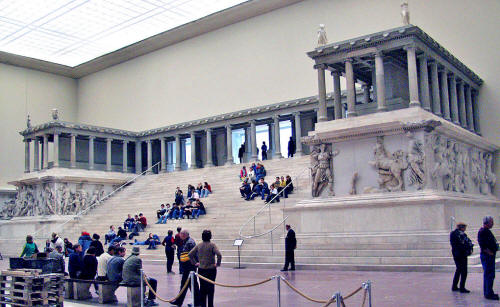
The Great Altar of Pergamos
In the year 165 BCE the Great Altar was constructed. Three hundred
sixty feet long, it depicted the battles of the gods and the giants
of old. Along with Athena and Aesculapius, a multitude of gods were
worshipped including Dionysus known as Bacchus the god of wine and
patron of the secret fertility cults of the east.
The city of Pergamos boasted one of the greatest libraries of the
ancient world. This was an immense library of over 200,000 volumes.
The library of Pergamos rivaled and even surpassed the famed
Library
of Alexandria. This library was funded by the king, Eumenes II who
imported shiploads of papyrus to copy books for the library until
the Egyptian recognizing the rivalry of this library declared an
embargo on papyrus. Not to be outdone, Eumenes II had its artisans
to develop a new writing material, parchment.
It was in 133 BCE that the final king of the Attalid dynasty,
Attalus III, willed the city of Pergamos to the Roman Empire as he
had no heirs to rule his kingdom. During this era the Chaldean
priesthood began to migrate to their new religious power center
located on the peninsula of Italia. It was John Walvoord, the
chancellor of the Dallas Theological Seminary who wrote in the
Bible
Knowledge Commentary,
“When the teachers of the Babylonian mystery
religions later moved from Pergamum to Rome, they were influential
in paganizing Christianity and were the source of many so-called
religious rites which have crept into ritualistic churches”
(The
Bible Knowledge Commentary, “Revelation” quoted in Through an
Ancient Looking Glass)
In the days of John the Revelator,
Pergamos was still recognized as
the power center for the Babylonian priesthood and the “seat or the
throne of Satan”. Over the centuries, the slow evolution of merging
the roots of the pagan religious rites to the apostate Christian
Church of Rome continued.
These rites were from the very religions
that the prophets of the Israel and Judah called an abomination to
the Lord. It was John the Revelator who identified this city as the
“Throne of Satan” and from whence will come the Black Horse and
Rider of the Apocalypse.
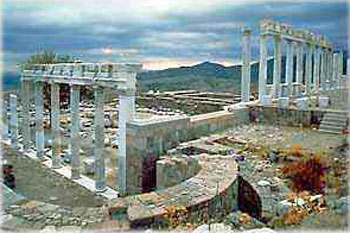
The Acropolis of Pergamos
In a rare 1983 picture shown below, John Paul II, the
Catholic Vicar of Christ is holding up the “twisted crucifix of
Christ” as he is facing east to the sun and the Egyptian obelisk
once dedicated to Ra, the Egyptian sun god. In front of the pontiff
are the adoring masses of pilgrims who pay their obeisance to a
practitioner of the ancient order of the Egyptian arts of Black Magick.
Before him is the Plaza of St. Peter’s Basilica, whose
surrounding courtyard and building monuments adored by the Catholic
faithful depict the ancient symbolism of the fertility sexual rites
of the pagan religions of the East. With the sacred womb of the
female goddesses and the phallus holding the “seeds” of the
god-kings, the Vatican exhibits today the same pathway of
enlightenment.
Go Back
The
Obelisk of the Egyptian Sun god Ra
The obelisk that is erected in the center of St. Peter’s Square in
the Vatican is 83 feet high and weighs 331 tons. It was first
erected under the orders of Emperor Augustus Caesar in the Julian
Forum located in the city of Alexandria in the 1st century CE. It
was later removed in 37 CE by the Emperor Caligula and placed in the
Circus of Nero in Rome.

The most famed and largest obelisk in the world, the Washington
Monument is not from Egypt.
It stands in the Washington Mall of
Washington D.C. the capital of the United States.
This Circus is called by some the
Vatican Circus where the Apostle
Peter was crucified. The word Vatican is a name that was coined
centuries later where St. Peter’s Cathedral was erected.
As the Egyptologist Labib Habachi stated,
Labib Habachi -
"Legend has it that in the Vatican Circus
innumerable Christians, including St. Peter, were put to death and
that the reason this obelisk was not later overturned as were all
the others in Rome was that it was looked upon as the last witness
to the martyrdom of St. Peter."
This obelisk was never toppled and as such the emperor
Nero obtained
his mythical status as a sorcerer. On the top was erected a bronze
globe with what was known to be the ashes of the two Caesars;
Augustus and Tiberius.
In the year 1586, Felice Peretti, known as Pope Sixtus V (1585-1590)
the “Iron Pope”, commissioned Domenico Fontana to transfer this
obelisk from the Circus of Nero to what was to become the Piazza St. Pietro in front of the Basilica of St. Peter.
Sixtus V was born on
the little village of Montalto in the desolate area of Marca
d’Ascoli. He later was known as Cardinal Montalto. On top was
erected the complex coat of arms with four symbols; a rampant lion
holding pears (Peretti means pears) and three mountains topped by a
star, the
mountains and the star of Sixtus V
There in the midst of the “Eight Wheel Path of Enlightenment” this
obelisk stands as a symbol of the glory of Egypt and the imprint of
Egyptian cultic influence on the Vatican over the ages.

The Egyptian Obelisk in the center of St. Peter’s Square
The entire path of enlightenment circles an obelisk called by some
the Obelisk of Cleopatra was created in Egypt in the 1st century
BCE. In the research of obelisks by the New Age author, Peter
Tompkins in his book, The Magic of Obelisks, he writes the
following:
Peter Thompkins –
“The Egyptians had developed a means of placing
theses huge blocks of granite directly onto a cubical pedestal which
had to be absolutely level in order to have the apex of the obelisk
truly vertical over its base…”
(Thompkins, Peter, The Magic of
Obelisks)
His research continued as to their purpose and use and found that
the obelisk was used in the worship of the ancient Egyptian Sun god,
“Ra”. (Ibid 7). To gain insight into this world of Black Magic, the
author “encountered the murky worlds of witchcraft, voodoo,
demonology, and the darkest recesses of the human mind”. (Ibid, p.2)
During this era, one of the
oldest and most famous of the Egyptian obelisks is the obelisk of Heliopolis,
most ancient surviving ‘needle’ in Egypt.
According to Thompkins, the obelisk of Heliopolis stood in the famed
city of Heliopolis:
Peter Tompkins –
“… with its temple to the sun, its 13,000 priests
chanting before a huge mirror of burnished gold, the sacred hawk in
the golden cage, the pyramidal ben-ben, and the sacred calf Mnevis
on its purple bed, was the greatest theological center in ancient
Egypt. …”
(Thompkins, Peter, The Magic of Obelisks)
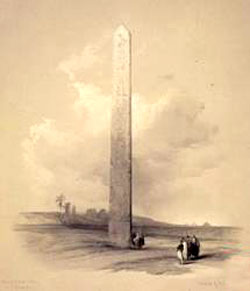
The obelisk of Heliopolis
This delta city of ancient Egypt, Heliopolis, was the capital of the
13th Lower Egyptian Nome. As a city of astronomy, the high priest
took the title name held by Imhotep in the 3rd Egyptian dynasty,
some scholars think was the Egyptian visor Joseph, the son if Jacob.
He was called wr-m3w, or “chief of observers” or the “greatest of
seers”. Heliopolis, called “On” in Egyptian Coptic, was the seat of
the sun-god Ra was the oldest and richest of the ancient seats
dedicated to sun worship.
Next to the obelisk of Heliopolis, the largest standing Egyptian
obelisk today is standing in the Piazza S. Giovanni in Laterano, the
square of St. John Lateran, the official cathedral of the bishop of
Rome. This cathedral is called the Sacred Lateran Church,
Universally for the City and the World, Supreme Mother of Churches.
This obelisk was the last obelisk to be brought from Egypt to Rome.
Constantine the Great wanted to bring it but did not have a large
enough ship to do so. It was Constantius II (317-361 CE) who had a
specially built ship and transported it from Thebes to Rome in 357
CE. Located initially on the Circus Maximus, by the time of the
reign of Pope Sixtus V, it had fallen, was broken and in disrepair.
It was repaired and re-erected in the Piazza S. Giovanni in Laterano.
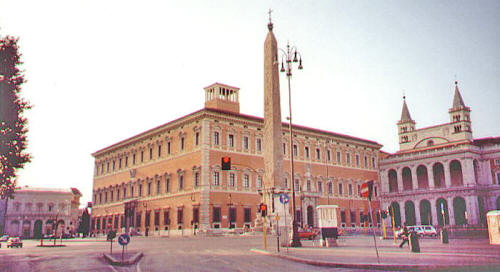
The Karnak Obelisk of Thutmoses III standing in the Square of St.
John Lateran.
Standing twenty meters high and weighing 21 tons, this obelisk was
originally carved in the reign of the Egyptian reign of Pharaoh
Thutmoses III and was placed in the temple of Amon-Ra in Karnak at
Thebes. Thutmoses III was thought to be the brother to the foster
mother of Moses, the Pharaoh Queen Hatshepsut.
Today in Rome, it represents the tallest and best preserved of
Egypt’s ancient symbols to the sun. Also on top of this obelisk,
Pope Sixtus V mounted the entire array of his heraldic symbols: not
only the three mountains with the star, but also
the lion holding
the pears.
The followers of the pagan or satanic religions of Egypt believed
that the spirit of Ra lived in the obelisk. Three times a day, the
worshippers of Ra were to face this obelisk and to pray to the god,
Ra. According to Cathy Burns in the book, “Masonic and Occult
Symbols Illustrated” , this practice has been transmitted over the
centuries in the occultic societies who also “face the obelisk”
daily. Here the obelisk represented the phallus of Osiris which was
cut into fourteen parts.
This symbol was later transferred to the
Canaanite god Baal, whom the prophets proclaimed the hatred of the
God of Israel to this false religion. Later in the Mystery religions
of the Greeks,
“Pan the goat god and god of sensuality were often
represented by the obelisk.”
(Burns, Cathy, Masonic and Occult
Symbols Illustrated)
With the death of the famed Cleopatra, the last Pharaoh of Egypt and
the wife of both Mark Anthony and Julius Caesar, we find the ascent
of the glory of Rome while the glory of Egypt faded into history.
The obelisks of Egypt were moved to many cities of the Roman Empire
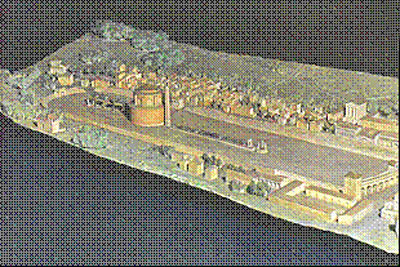
The site of the execution of Paul and the crucifixion upside down of
the Apostle Peter in the Circus of Nero near the “Cleopatra Obelisk”
of Egypt
It was in 66 CE when the Apostle Paul, the emissary of Yahshua to
the gentiles was arrested and executed in the Circus of Nero. When
the news reached Peter who was ministering to the Nazarene believers
in Gaul (central Europe) that he immediately went to Rome to assist
the fledging church.
They were meeting in the home of Senator Rufus Pudens and his Celtic Silurian wife who was the princess of Wales.
Their home was known as the “Palladium Britannica” (the Palace of
the British) where the Basilica Pudentianna presently stands in Rome
today.
Soon after his arrival, Peter was arrested and put in the famed and
feared Gemonium or the Tullian Keep known today as the Mamertine
Prison. This two chambered cell was cut into solid rock, one over
another with the only entrance through the ceiling. In 50 CE, it was
described by the Roman historian Sallust as:
Roman historian Sallust -
“In the prison called the Tulian, there is
a place about ten feet deep. It is surrounded on the sides by walls
and is closed above by a vaulted roof of stone. The appearance of it
from the filth, the darkness and the smell is terrific.”
(Taylor,
John W., The Coming of the Saints)
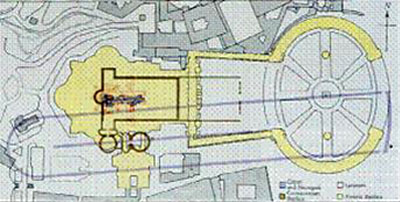
The tomb of the Apostle Peter on the embankment of
the Circus of
Nero at the site of the Great Altar of St. Peter’s Cathedral
According to George F. Jowett, in
The Drama of the Lost Disciples we
read:
George Jowett –
“It was here that Jugurtha was starved and went
insane, and Vereingirorix, the famed and feared Druidic Chief was
murdered by Julius Caesar. Yet here incarcerated in the filth and
stench of decades of human debris, Peter was bound in chains for
nine months, standing upright to a column, never able to rest.
Peter’s undaunted spirit was such, that in these nine months, he
converted his gaolers, Processus, Martinianus, and forty-eight
others to the ministry of Christ.”
(Jowett, George F., The Drama of
the Lost Disciples)
It was at the site of the Circus of Nero with the obelisk that was
standing along the central spine, that the Apostle Peter was
crucified upside down with his feet tied by a rope about 67 CE.
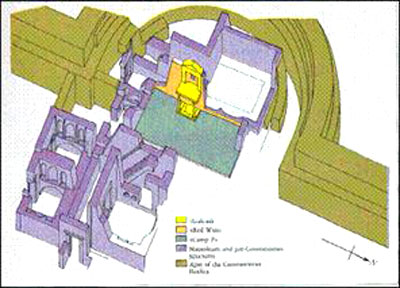
The tomb of Peter and the 1st century monument and graffiti in honor
to him
in the catacomb beneath the “seat of Peter” in St. Peter’s
Cathedral in the Vatican.
According the ancient traditions of the early church, the body of
Peter was given to the believers of the Roman Christian Ecclesia
whose home church was in the home of the Roman Senator Rufus Pudens
at the Palladium Britannica on one of the seven hills of Rome called
the Viminale Hill.
There they took his body to the surrounding embankment of the Circus
of Nero and placed Peter’s grave. Later they build a memorial site
for the Roman Christian believers. As seen in the picture above of
the Circus of Nero, the site for the tomb of Peter was later built
the altar of the Basilica of St. Peter’s by the Emperor Constantine.
Later in the center of the piazza of St. Peter’s the Obelisk of
Cleopatra was re-erected and once stood in the spine of the Circus
of Nero.
Today, the ministry and ritual worship within the Vatican no longer
serves the God of Israel. They no longer seek to preserve the Torah
that was given to Moses and His chosen ones fleeing their bondage in
Egypt. The imperial religious center of the Pharaohs which the
Israelites were fleeing from is now the entombed in the architecture
and monuments at the Vatican. There in the home of apostate
Christianity the monuments of the ancient Sun god, Ra reign supreme.
Go Back
The
Twisted Crucifix of Christ of Mithra
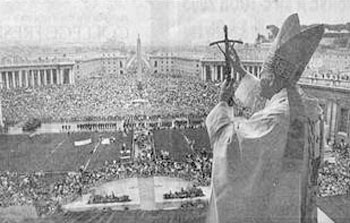
Pope John Paul II (1983) holding the bent crucifix facing towards
the east and the Egyptian obelisk
It was in 1963 when the Twisted Cross Crucifix was first presented
to the Catholic public by Giovanni Battista Montini as Pope Paul VI
(June 21, 1963-August 6, 1978), instead of the traditional Christian
cross of Jesus. The occultic authority took notice for the meaning
of this act was loud and clear: the alliance of
the Jesuits and
the
Illuminate had taken over the Vatican.
The final trump card of the
Black Pope would soon come and the Papacy would be fully under the
control of the Order of Ignatius of Loyola, the Society of Jesus,
called the Jesuits. The era of the “false prophet” of Revelation,
the anti-Christ and the final control of the globalists in the
creation of the New World Order would formally and finally be
completed.
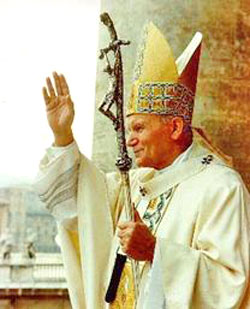
Pope John Paul II and the Bent Crucifix
Papa Woytyla with all his loving and fatherly charisma still
meticulously followed the script of the progressive involvement of
the Vatican “superforce” that had control of the Papal Curia and the
governance of the Holy See. It was John Paul II who first used in
public the coin words, “New World Order”.
As the sun traveled the sky in toil labor, so also did this Pontiff
the “Solaris laboris” as
prophesied by St. Malachy in 1153 for the
110th pope in his vision of the last popes. Throughout his travels
around the world he presented the Twisted Cross Crucifix to the
public as the symbol of the most ancient crooked staff of Mithra.
The favorite emblem of John Paul II in his travels was the Twisted
Crucifix whom Piers Compton in his book, “The Broken Cross: Hidden
Hand of the Vatican” stated that the Bent Crucifix is:
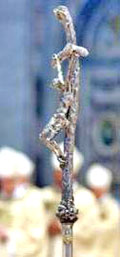 Piers Compton - Piers Compton -
“…a sinister symbol, used by Satanists in the sixth
century, that had been revived at the time of Vatican Two . This was
a bent or broken cross, on which they displayed a repulsive and
distorted figure of Christ, which the black magicians and sorcerers
of the Middle Ages had made use of to represent the Biblical term
‘Mark of the Beast’. Yet, not only Paul VI, but his successors,
the
two John-Pauls, carried that object and held it up to be revered by
crowds, who had not the slightest idea that it stood for
anti-Christ.” (Compton, Piers, The Broken Cross: Hidden Hand of the
Vatican)
The origin of the Mithraism’s crooked staff is rooted in a history
centuries prior to the crucifixion of Yahshua ha Maschiach (Jesus
the Messiah) hanging on a tree.
This staff depicted a sinister image
of a sickly man and the current papal staff depicts a thin sick
emaciated Christ.
Piers Compton –
“This "Twisted Cross" was created by Black Magick
Satanists -- sorcerers and magicians -- in the 5th Century to mock
the regular Catholic Crucifix, creating the repulsive and distorted
figure of Jesus hanging loosely on a cross, on which the top, and
both side ends were noticeably "twisted" upward.
(Compton, Piers,
The Broken Cross: Hidden Hand of the Vatican)
In the late 1760s, Mayer Amschel Rothschild drew up the
organizational plans for the creation of the Illuminati. It was
Adam Weishaupt in Frankfurt, Germany who formed the
Masters of the
Illuminati in 1776. This alliance in Frankfurt, Germany of Mayer Amschel Rothschild and Adam Weishaupt along with
Jacob Frank, the
successor of the Shabbatai Zevi formed the beginnings of the final
alliances that seek to control this planet earth.
According to
scholars of the occult, it was after Adam Weishaupt formed the
Masters of the Illuminati in 1776, that the Twisted Cross became an
Illuminist symbol representing the coming New Age, Masonic Christ
and his 'Mark of the Beast'.
Mithra was known as the “angel of light” who brought its followers
the “illuminated light.” When we follow the etymology of Mithra we
find that the root meaning of the word goes back to “Lucifer” whose
root in Latin is Luc or Luz.
Isaiah 14:12 –
“How you are fallen from heaven, O Lucifer, son of
the morning ! How you are cut down to the ground, you who weakened
the nations! For you have said in your heart’ I will ascend into
heaven, I will exalt my throne above the stars of God; I will also
sit on the mount of the congregation on the farthest sides of the
north; I will ascend above the heights of the clouds, I will be like
the most High.” Yet you shall be brought down to Sheol, to the
lowest depths of the pit.”
Lucifer is described as the originator of illuminated light and was
worshipped as “the Mediator” and the Canaanite Lord of the covenant
“baal-berith”.
Judges 8:33 –
“And it came to pass, as soon as Gideon was dead, that
the children of Israel turned again, and went a whoring after Baalim,
and made Baal-berith their god.”
That Mithraism arose in human history prior to
Christianity was good
strategic planning by the arch-deceiver, Lucifer, known as Satan.
This was the same “accuser of the brethren” who was called the
“dragon” and will be cast down by Michael, the “prince” of the
Most
High to this earth when the final war, the war with the woman (the
“saints” and the “chosen ones”) in the last days is fought.
The Early Church Fathers, like Origin,
Tertullian and Justin, tried
to trace part the origins of apostate Christianity to an adaptation
of Mithraism. That it was. The corruption of the testimony of the
Jewish rabbi, Yahshua ha Maschiach (Jesus the Messiah) who claimed
“I am the light of the world” (John 8:12) to Mithra (Lucifer) as the
“light bearer” was a strategy set into motion prior to the birth of
Jesus. It was brilliant and well conceived.
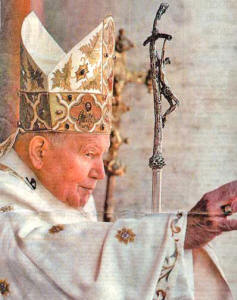
John Paul II with the Bent Crucifix of Mithraism
The concept of a “corrupted idea” to be implanted into cultural life
decades or centuries prior to the revelation of “truth” is one of
the greatest strategies of satanic forces. It has been repeated over
and over throughout the ages when the revelation of truth was
preempted by the planting of a falsehood first. Many Church
historians are too lazy to dig deeper into the dim and mystic lore
of the ancients.
The Dagon Miter of the Papacy
Two of the most poignant stories of the Israelites during the time
of the Judges are the story of Sampson and the story when the
Ark of
the Lord was captured by the Philistines in Ashdod. Both of these
stories are related to the Philistines of old whose modern day
descendants can be seen in the Palestinians in Israel. Both of these
stories are related to the Philistine god, Dagon.
Sampson and Philistine god Dagon
Judges 16:23 –
“Now the lords of the Philistines gathered together
to offer a great sacrifice to Dagon their god; and to rejoice. And
they said; “Our god has delivered into our hands Sampson the enemy!”
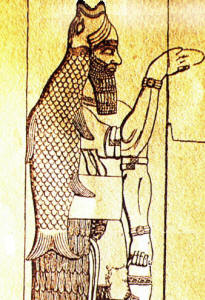
Dagon, the sun-fish, clearly displayed with fish attire and mitre.
The Ark of the Covenant and Dagon
I Samuel 5:1-7 –
“Then the Philistines took the ark of God and
brought it from Ebenezer to Ashdod. When the Philistines took the
ark of God, they brought it into the house of Dagon and set it by
Dagon. And when the people of Ashdod arose early in the morning,
there was Dagon, fallen on its face to the earth before the ark of
the Lord. And they took Dagon and set it on its place again.
And then they arose early the next morning there was Dagon, fallen
on its face to the ground before the ark of the Lord. The head of
Dagon and both the palms of its hands were broken off on the
threshold; only Dagon’s torso was left of it. Therefore neither the
priest of Dagon nor any who come into Dagon’s house tread on the
threshold of Dagon in Ashdod to this day.
But the hand of the
Lord was heavy on the people of Ashdod, and He
ravaged them and struck them with tumors, both Ashdod and its
territory. And when the men of Ashdod saw how it was, and they said,
“The ark of the God of Israel must not remain with us, for His hand
is harsh towards us and Dagon our god.”
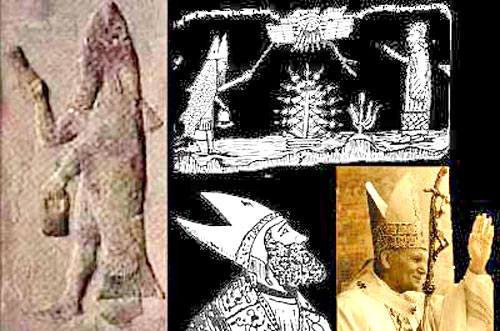
The Sumerian fish god, the priests of Enki and the Miter of the Pope
One of the many mystery cults absorbed by the apostate Christian
Church in the first four centuries was Philistine fish-god called
Dagon. The most renown temples of Dagon were at Gaza (Judges
16:21-30) and at Ashdod (1 Samuel 5:3,4; 1 Chronicles 10:10.) This
Fish-god in the Philistine culture was also known as the devil.
The representation of Dagon is found in the architecture of the
Sumerians and the Philistines. It was portrayed as the face and
hands of a man with the lower torso or body of a fish. These images
of Dagon are even more ancient than the Philistine culture of the
Judges but hark back to the first known civilization of mankind,
the Sumerians. The upper Sumerian inscription depicts two Sumerian
priests where the left priest is wearing the miter of the fish-god
and is holding a staff for sprinkling the hold water which he is
carrying in his opposite hand.
According to Berossus, these divine fish-men appeared coming ashore
from the “Erythrean Sea”. This was the ancient Arabian Sea. In the
Sumerian tablets it was EN-KI who came and settled in a land called
E.RI.DU (“house in faraway built”). Archeologist claim that this was
Eridu in southern Mesopotamia. (Sitchin, Zecharia, the
12th Planet) When we compare this text with
the Bible, this “fish god” appears to have arrived in the
ante-diluvium era in the days of Enoch when
the Nephilim or the
Watchers came to this planet.
Their arrival, on the engraving above,
appears to be in a flying vehicle not unlike a modern day airplane.
Their mission as recorded in the Jewish inter-testament book,
the
Book of Enoch found in the Qumran fragments, resulted in the
greatest rebellion in the days of Enoch against God.

Pagan priests as half-fish sprinkling holy water
Above we see the same mitered Dagon fish-god engraved on a
stone relief that came from a temple laver in the ancient empire of
Assyria. It is now housed in the Pergamum Museum in Berlin, Germany.
We see each priest is wearing a fish-head mitre representing the
Sumerian-Philistia-Babylonian god Dagon.
The ancient Hebrew root for Dag-on, dag is pronounced as
dawg (Strong’s 1912). It comes from the
fertility symbol of fish rapidly spawning or multiplying. The second
syllable of the word Dag-On is pronounced as gohn which is derived
from the word sun.
It was the English archeologist Austen Henry Layard who excavated
the capital of the ancient Assyrian Empire called Khorsabad or
Persepolis in the late 1840s. It was 1850 when the magnificent royal
library of Assyrian King Ashurbanipal was unearthed. In the palace
chamber at Nineveh he found a room that was stacked with 30,000 clay
cylinders and tablets. On each cylinder was a micro wedge-shaped
cuneiform script.
These tablets and cylinders were packed into
wicker baskets and shipped to the British Museum. It would later
take decades of painstaking work translating this script by reading
it with a magnifying glass. In this same library was also found the
Babylonian account of the Biblical story of the Flood of Noah,
called Ut-Nipishtim on the clay cylinders.
As archeologist Layard described this fish-god priest in his book,
“Babylon and Nineveh”,
Austen Henry Layard -
"The head of the fish formed the mitre above
that of a man, while its scaly, fish-like tail fell as a cloak
behind, leaving the human limbs and feet exposed."
(Layard, Austen
Henry, Babylon & Nineveh)
Later the mitre of the fish-god was found as the ancient mystery
goddess of Asia Minor and Syria, Cybele. We see again the same mitre
of the fertility fish-god representing the Sun-god Dagon again with
a scepter or a trident rod in her hand.
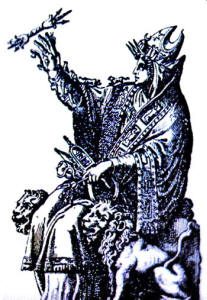
Cybele, the mystery goddess of Asia Minor and Syria, with an
Episcopal mitre on her head.
Cybele (Sybil) was the Roman Earth Goddess who was called the great
queen mother goddess or the Magna mater of Rome symbolized by her
throne and lions. She represented Gaia, the deified earth which the
New Age writers have resurrected in modern times with the living
earth Gaia theory.
In her hand she holds a frame drum, her bowl of
prophecy and by her piercing gaze gives proclamation to her power of
prophecy. Many of the attributes of Cybele (Sybil) are recognized in
the Sumerian goddess Inanna. The Basilica of Saint Peter actually
stands upon the former site of Cybele's main temple in Rome.
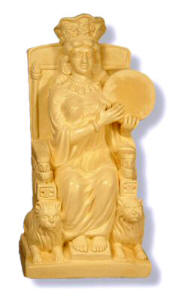
Goddess Cybele on her lion throne
This Queen Mother or the Magna Mater was spoken of harshly by the
prophet Jeremiah in Jerusalem. With the apostate Christian Church
elevating Mary the mother of Jesus to a deified state as the Queen
Mother of Heaven, she assumed the role of the accursed state of Cybele the Roman goddess. This was the same “Queen of Heaven”, known
as Asherah and Ishtar.
Go Back
|
















 Piers Compton -
Piers Compton -





